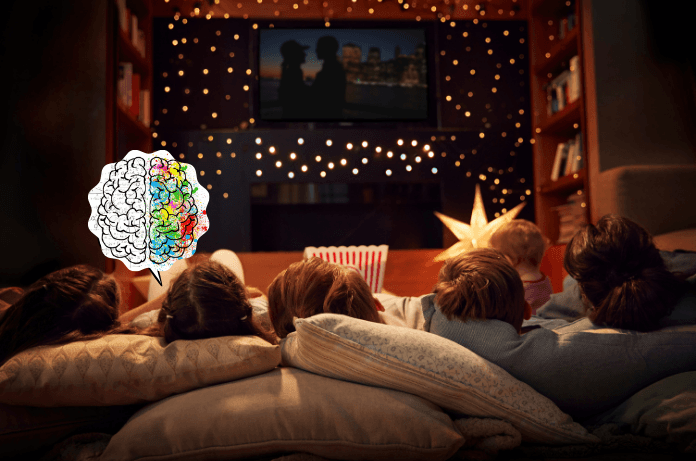Scientists scanned the brains of people to understand how people’s brain processes naturalistic, real-world experiences while watching movies. The neuroscientists have created the most detailed functional map of the brain to date.
Unlike traditional lab settings, in this study, the research team wanted to investigate whether watching movies during fMRI scanning could provide insights into how the brain’s functional networks respond to complex audio and visual stimuli.
To catch the brain functions during movie watching, we used movie-watching fMRI data of 176 healthy young adults from the Human Connectome Project (HCP) database, said Dr. Reza Rajimehr, Research Scientist in Robert Desimone lab at McGovern Institute for Brain Research, Massachusetts Institute of Technology.
These adults were scanned in a 7T scanner while watching short movie clips. These movie clips were from Hollywood movies, which contained a variety of people, animals, objects, sounds, actions, and many more.
This study found that watching movies engages 24 brain networks that parallel our day-to-day mental functions—like social interaction, empathy, and memory processing. This “naturalistic” research approach offers fresh insights into our brain’s remarkable adaptability and processing power.
Understanding Naturalistic Brain Processing: How Movies Mimic Life
In everyday life, our brains constantly integrate sights, sounds, emotions, and memories to form cohesive experiences. Movies, with their dynamic audio-visual elements and emotional arcs, offer a controlled yet immersive experience that mirrors real-life scenarios. This immersive quality activates a multitude of brain regions simultaneously, including:
- Sensory Cortices for visual and auditory processing, helping the brain parse sights and sounds,
- The Amygdala and Prefrontal Cortex for emotional regulation, allowing us to empathize with characters,
- Memory Networks help connect past experiences with current events in the movie.
Neuroscience Insights and Practical Applications
Enhancing Social Skills and Empathy
Movies often depict intricate social interactions that require the viewer’s brain to decode body language, vocal cues, and context—similar to real-life communication. Studies show that this kind of neural engagement can improve empathy and social cognition, suggesting that watching certain films or scenarios could aid people in developing better social skills. For example, people with autism or social anxiety might benefit from film-based therapies that train the brain to interpret social cues more effectively.
The researchers explain that understanding how the brain processes these social cues during movie-watching could lead to therapeutic approaches for conditions affecting social behavior, helping people relate better to others in their lives.
Cognitive Focus and Multitasking
In busy real-world settings, like navigating through a crowd or multitasking at work, our brains must constantly prioritize information. Movie scenes that involve multiple plotlines or split-second action sequences mimic these demands, requiring the viewer’s brain to filter out irrelevant stimuli and focus on key details.
- Application in ADHD Management: For individuals with ADHD, who may struggle to focus, movie-watching exercises that train attention networks could be a valuable tool for strengthening focus. Schools and workplaces might incorporate similar techniques, using multimedia to improve engagement and information retention.
The Educational Power of Movies
Traditional learning methods often engage limited brain areas, such as those for memory recall. However, movies activate a wider range of neural networks through storytelling—connecting facts with emotions, visuals, and sounds. This multisensory engagement aligns with the brain’s natural processing style, making information more memorable and relatable.
- Application in Education: Teachers can use films or dynamic multimedia to introduce complex topics, like history or science, allowing students to learn in a way that mimics natural brain functioning. By presenting information in a narrative format, educators can make learning experiences more impactful.
Researchers believe that by understanding how our brains respond to rich, real-life stimuli, they can inspire new educational models that help students grasp complex concepts more naturally.
Emotional Resilience and Mental Health Support
Movies also evoke emotions, from joy to suspense, engaging brain regions associated with mood regulation. This research holds promise for mental health therapies by highlighting how controlled exposure to certain stimuli can help train emotional resilience. For example:
- PTSD and Anxiety: Watching carefully selected films may allow individuals to experience emotions safely, gradually reducing their emotional sensitivity to certain triggers.
- Mood Disorders: People with depression or mood disorders could benefit from “emotion-training” exercises inspired by these studies, gradually retraining their brains to balance emotional responses.
The Influence of Cultural Contexts on Brain Activity
Different genres, cultural themes, and narratives can elicit unique responses in brain regions associated with memory, identity, and emotion. For instance, watching a familiar cultural narrative might enhance memory and emotional recall by engaging the brain’s network more deeply, while unfamiliar settings encourage cognitive processing and curiosity.
- Global Relevance: This could inform international education by incorporating culturally diverse films into curricula to boost engagement, empathy, and cultural understanding, especially in multicultural classrooms.
The Future of Personalized Neurotherapy
As this research advances, individualized brain mapping could inform Neurotherapy, where movie scenes or story types are tailored to activate specific networks in each person’s brain for therapeutic outcomes.
- Potential for Custom Mental Health Interventions: If someone struggles with anxiety, scenes with gradual suspense could be used to desensitize their responses to stress in a controlled environment. Conversely, scenes evoking joy might stimulate positive brain pathways, helping to alleviate depression symptoms.
Future of Brain-Based Innovations
The study of brain activity during movie-watching isn’t just a look at entertainment’s impact on the mind; it’s a step toward understanding how our brains thrive on complex, engaging information. By using movies as a window into the brain’s naturalistic processing, researchers are opening doors to potential innovations in therapy, education, and mental health support. This research underscores our brain’s capacity to process vast, interconnected information seamlessly, offering exciting possibilities for helping individuals connect, learn, and emotionally engage with the world around them.

